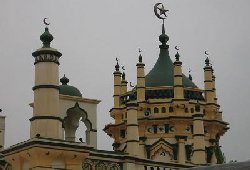Ramadan falls on the 9th month of the Islamic calendar. It is a time of worship, reflection and seeking self-purification of one's soul and body. Muslims perform extra devotional activities during the month of Ramadan. In the evenings, the Mosques are filled with people attending special night prayers, known as Taraaweeh.
Street feasts
Every year during the month of Ramadan, the Geylang Serai (Malay Village, a replica of traditional Malay houses of olden times) comes alive with street bazaars after Taraaweeh prayers. Most of the Muslims live or gather here so it is always filled with large crowds. The street bazaars and night market are called 'pasar malam' and are filled with people selling festive items. You can buy new carpets, clothes, bags, nasheed CDs and general household items.
A wide variety of food is also sold at the bazaar. This includes kueh -mueh (Malay cakes and pastries), otah-otah (grilled fish paste in banana leaves), cakes, buns, breads, curry, noodles and delicious curry puff pastries. During the night, the whole place is lit up with glittering lights and decorations, giving the area its much-cherished ethnic flavor.
Bright lights
The Jalan Sultan area of the city is another hub of activity during Ramadan. The oldest Mosque in the city, Sultan Mosque, which is a national monument, is situated here. The whole area is decorated with bright lights and a wide variety of food is sold.
Most Muslims buy food in Geylang Serai or Jalan Sultan to bring home to eat to break their fast or at Sohoor (pre-dawn) time. Both Muslims and non-Muslims enjoy these seasonal street feasts.
One dish which is only served during Ramadan is a rice porridge which is cooked in every Mosque to give out to the Muslims after Asr' (afternoon) prayers. Most Muslim families break their fast by eating the porridge first. It symbolizes Shukr, gratitude to Allah.
Preparation for 'Eed
The preparation for 'Eed Al-Fitr begins during Ramadan. Women are busy sewing beautiful new curtains and buy new clothes for the whole family. In addition, 5 days before 'Eed, the women will start baking cakes like marble cake and cake lapis (layered butter and chocolate cake) and traditional Malay delicacies like kueh makmur, a rich baked pastry filled with roasted peanuts or almonds mixed with sugar and formed into a leaf shape, kueh tart (pineapple tarts), kueh bangkit (cookies made of tapioca flour) and many more.
Some families re-decorate their homes in preparation to receive all the guests who will visit them during the festival. Most families also decorate their houses with glittering lights on their windows, or around the yards of their houses. Some Muslim families light oil lamps during the seven days preceding the festival.
Hari Raya Puasa
'Eed Al-Fitr, or Hari Raya Puasa as it is known in Singapore, is one of the highlights of the Muslim cultural and religious calendar. It is celebrated at the end of the fasting month, when the new moon is sighted. The Malay words ‘Hari Raya' translate as 'Day of Celebration' or the ‘Festival of Breaking the Fast'. Many non-Muslims confuse Hari Raya Puasa with the Muslim New Year.
The celebrations begin with the birth of the new moon of Shawwaal, the 10th month of the Islamic calendar. Muslims usually attend 'Eed prayers in the Mosque in the morning. This is then followed by a visit to the cemetery where deceased loved ones are remembered, graves are cleaned and cleared of overgrowth, and prayers are offered to Allah. Some Muslims visit a day or two before 'Eed instead.
Best dress
The Malays are usually decked out in their best traditional outfit to mark the special occasion. The men usually wear Baju Melayu (loose shirt with trousers) with kain samping (short over-sarong of rich material), while the Baju Kurung (tunic top) is the quintessential Malay attire for females. Married families dress in the same color to represent unity.
In the afternoon, everyone gathers with their families and close friends for a grand feast. It is also customary to seek forgiveness from family and friends, and to renew the sense of community. The younger generations seek forgiveness and blessings from their parents, which is very essential.
When visiting, the guests and the hosts exchange ‘salaams' and greetings of “Selamat Hari Raya”, which means “Wishing you a joyous day of celebration”.
Feasting
There are a wide variety of delicious spicy dishes and traditional delicacies to eat throughout the first three days of 'Eed Al-Fitr. The spicy dishes are ketupat (rice dumpling wrapped in coconut leaves), lontong (rice and vegetable soup), satay (grilled meat on a skewer), sambal sotong (chilly squid) and beef rendang (beef cooked with spices and coconut milk). Other festive delicacies include lemang (glutinous rice cooked in bamboo tubes), serunding (desiccated fried coconut with chillies) and sambal goreng (fried meat and vegetables with chillies).
Green gifts
The Muslims also give ‘duit raya ' (gifts/ packets of money) to children and old folks when they go visiting. The packets are usually green in color and children look forward to getting these money tokens on Hari Raya Puasa.
Although the first three days are celebrated on a grand scale, many Muslims in most Asian countries celebrate 'Eed Al-Fitr throughout the whole month. One explanation they give is that Muslims fast for an entire month in Ramadan and therefore their reward is a month of celebrating 'Eed Al-Fitr too! Another reason to extend the celebration is so that non-Muslim friends and neighbors can also join in.


 Home
Home Discover Islam
Discover Islam Quran Recitations
Quran Recitations Lectures
Lectures
 Fatwa
Fatwa Articles
Articles Fiqh
Fiqh E-Books
E-Books Boys & Girls
Boys & Girls  Ramadan
Ramadan Fatwa Audios
Fatwa Audios Month of Mercy
Month of Mercy Women
Women Eed Al- Fitr
Eed Al- Fitr Food Recipes
Food Recipes Videos
Videos

 Prayer Times
Prayer Times












